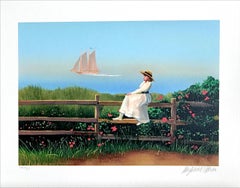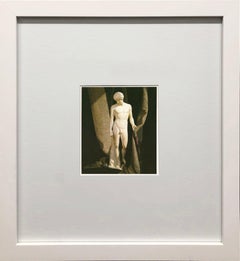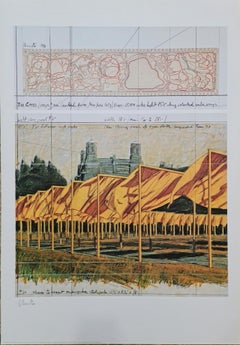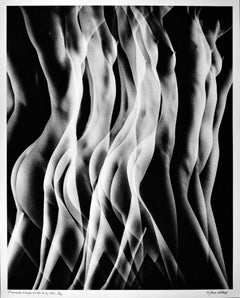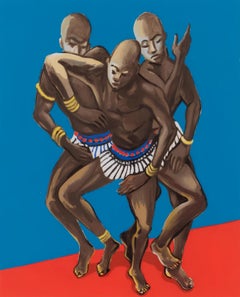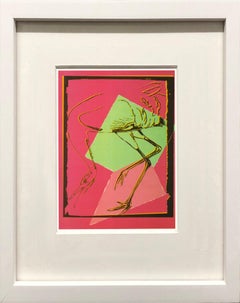1990s Art
to
2,099
4,305
2,944
2,501
1,720
2,015
Overall Width
to
Overall Height
to
7,534
21,284
158,759
232,825
1,969
2,237
4,913
6,410
5,806
13,273
19,658
25,639
18,282
13,575
5,375
4,453
1,930
1,696
1,126
446
293
181
141
91
82
69
21
15
4
6,998
4,997
902
4,747
2,368
1,654
1,524
1,217
1,142
904
827
665
658
599
574
547
544
338
323
307
298
294
279
4,464
3,601
1,971
1,622
1,486
475
177
161
151
146
2,471
3,111
9,522
3,689
Period: 1990s
DREAMING Signed Lithograph, Seaside Landscape, New England Woman, Boat
Located in Union City, NJ
DREAMING is an original hand drawn lithograph by the American woman artist Sally Caldwell-Fisher, printed using hand lithography techniques on archival Arches paper 100% acid free. D...
Category
Contemporary 1990s Art
Materials
Lithograph
Robert Mapplethorpe 'Antinous' 1994
Located in Brooklyn, NY
This striking image by Robert Mapplethorpe, titled Antinous, reflects the artist’s deep engagement with classical form and idealized beauty. Featuring a statue of Antinous—beloved of...
Category
1990s Art
Materials
Offset
Christo, 'The Gates Collage', Lithograph, 1990
Located in Pembroke Pines, FL
Artist: Christo (1935 - 2020)
Title: The Gates Collage
Size: 39" x 27" inches
Type: Lithograph Poster
Hand Signed
Christo was born in 1935 in Gabrova, Bulgaria. (He would drop his J...
Category
Contemporary 1990s Art
Materials
Offset
Large format vintage multiple exposure female nude, signed by Jack Mitchell
Located in Senoia, GA
16 x 20" vintage silver gelatin photograph, multiple exposure female nude. Titled, numbered, dated, and signed by Jack Mitchell on the recto. Comes directly from the Jack Mitchell Ar...
Category
Abstract 1990s Art
Materials
Silver Gelatin
Composition, Poems of Léopold Sédar Senghor, Lois Mailou Jones
Located in Southampton, NY
Silkscreen on vélin paper. Paper Size: 22 x 17 inches. Inscription: Unsigned and unnumbered, as issued. Notes: From the album, Poems of Léopold Sédar Senghor, 1996. Published by The Limited Editions Club, New York; printed by Studio Heinrici, Ltd., New York, under the direction of Alexander Heinrici, New York, 1996. Excerpted from the album, CC examples of this album have been printed by Daniel Keleher at Wild Carrot Letterpress. This edition was designed and set in Bodoni types by Dan Cart and Julia Ferrari at Golgonooza Letter Foundry. The silkscreen prints were made by Alexander Heinrici at Studio Heinrici.
LOIS MAILOU JONES (1905-1998) was an African American artist and educator, often associated with the Harlem Renaissance. Jones was raised in Boston by working-class parents who emphasized the importance of education and hard work. After graduating from Boston’s School of the Museum of Fine Arts, Jones began designing textiles for several New York firms. She left in 1928 to take a teaching position at Palmer Memorial Institute in North Carolina. At Palmer, Jones founded the art department, coached basketball, taught folk dancing, and played the piano for Sunday services. Two years later, she was recruited by Howard University in Washington, D.C., to join its art department. From 1930–77, Jones trained several generations of African American artists, including David Driskell, Elizabeth Catlett, and Sylvia Snowden...
Category
Expressionist 1990s Art
Materials
Screen
$1,996 Sale Price
20% Off
Andy Warhol 'Vanishing Animals: Whooping Crane' 1991 Pop Art Vintage
By Andy Warhol
Located in Brooklyn, NY
Offset lithograph from Andy Warhol: Vanishing Animals, a portfolio of six works published by te Neues in 1992 and printed in Germany. This particular image features the whooping cran...
Category
Pop Art 1990s Art
Materials
Offset
BASKET DRAWING Signed Lithograph Free-form Abstract Drawing Graphite Pearl Blue
By Dale Chihuly
Located in Union City, NJ
BASKET DRAWING, by Dale Chihuly(American b.1941) renowned glass sculpture artist depicts one of his signature abstract basket forms. This unique, limited edition lithograph was print...
Category
Abstract 1990s Art
Materials
Lithograph
David Hockney, Letter H, from Hockney's Alphabet, 1991
Located in Southampton, NY
This exquisite lithograph by David Hockney (born 1937), titled Letter H, from the folio Hockney's Alphabet, Drawings by David Hockney, originates from the 1991 edition published by A...
Category
Contemporary 1990s Art
Materials
Lithograph
$1,196 Sale Price
20% Off
Untitled 25, Minimalist Lithograph with pastel by Stephen A. Davis
Located in Long Island City, NY
Stephen A. Davis, American (1945 - ) - Untitled 25, Year: 1999, Medium: Lithograph with hand colored pastel, signed and dated in pencil lower right, Image Size: 23 x 16 inches, Si...
Category
Minimalist 1990s Art
Materials
Pastel, Lithograph
English 20th century landscape with a pussy cat, buttercups, daisy's and flowers
Located in Woodbury, CT
Alison Bolton studied fine art at Salisbury School of Art and Hornsey College of Art with Maurice de Sausmarez. After leaving college, Alison resumed painting once her children were ...
Category
Modern 1990s Art
Materials
Oil, Board
Mid-Century 29977-30 #16 Nude Portrait Silver Gelatin Print by Bruce Weber
By Bruce Weber
Located in New York, NY
This exquisite silver gelatin print by celebrated American photographer Bruce Weber showcases the artist's signature mastery of light, shadow, and form. Titled "29977-30 #16 Nude Por...
Category
1990s Art
Materials
Silver Gelatin
Carmen Console 'Chevy Camaro Tech Data 1967-1993' 1993- Offset Lithograph
Located in Brooklyn, NY
Paper Size: 23 x 35 inches ( 58.42 x 88.9 cm )
Image Size: 22 x 34 inches ( 55.88 x 86.36 cm )
Framed: No
Condition: A-: Near Mint, very light signs of handling
Additional Deta...
Category
1990s Art
Materials
Offset
$60 Sale Price
20% Off
Arman Roland Garros French Open 2002 Vintage
By Arman
Located in Brooklyn, NY
This 2002 Roland Garros poster by Arman is a remarkable piece that blends the worlds of tennis and contemporary art. Its dynamic use of assemblage and bold, abstract design capture t...
Category
Contemporary 1990s Art
Materials
Offset
Red Lamp
Located in Boston, MA
Artist: Lichtenstein, Roy
Title: Red Lamp
Date: 1992
Medium: Original lithograph on Rives BFK paper
Unframed Dimensions: 21.5" x 24"
Framed Dimensions: 32" x 34.5"
Signature:...
Category
Pop Art 1990s Art
Materials
Lithograph
Kate Moss
Located in New York, NY
Listing includes framing with UV plexi and a 14 day return policy.
This is available for pick up framed at Los Angeles gallery at no additional charge. For transport the US and internationally, please inquire for more details.
Kate Moss by Glen Luchford...
Category
1990s Art
Materials
Photographic Paper, Silver Gelatin
$20,000
“ Pilchuck Aerial”
By Dale Chihuly
Located in Warren, NJ
This is an Dale Chihuly Skagit Blue Pilchuck Aerial, 1996. In very good condition no cracks or breaks. Buyer is reasonable for all shipping cost.. 400 made
Category
1990s Art
Materials
Glass
Jackson Pollock 'Number 32' 1990- Offset Lithograph
Located in Brooklyn, NY
This is a high-quality reproduction of Jackson Pollock's iconic *Number 32*, printed on premium 250g paper with elegant deckled edges for a refined finish. The artwork captures Pollo...
Category
1990s Art
Materials
Offset
$200 Sale Price
20% Off
Lovers on the Couch
Located in Los Angeles, CA
Christian Marche
1935-2008
Marche was a prolific French artist best known for being one of the most significant pinball machine illustrators of the 1960s and 1970s.
He illustrated ...
Category
1990s Art
Materials
Canvas, Oil
$2,016 Sale Price
20% Off
Investigations, signed, with Guggenheim Museum & Leo Castelli Exhibition Labels
Located in New York, NY
Robert Morris
Investigations (with Guggenheim Museum Labels), 1990
Graphite drawing on Mylar. Framed with the original Guggenheim Museum label (lent by Sonnabend), & Castelli Gal...
Category
Minimalist 1990s Art
Materials
Mylar, Graphite
Roy Lichtenstein 'La Sortie' 1994 Vintage Pop Art
Located in Brooklyn, NY
La Sortie is an offset lithograph by Roy Lichtenstein, created as part of a portfolio of six Lichtenstein prints published by the Guggenheim Museum and now out of print. This work ex...
Category
1990s Art
Materials
Offset
And then and then... (pink) Limited Edition (print) by Takashi Murakami, signed
Located in Hong Kong, HK
And Then and then and then and then and then (Pink), 1999 by Takashi Murakami
Offset print, in silver ink signed and numbered by the artist
26 4/5 × ...
Category
Pop Art 1990s Art
Materials
Offset
Vertical Drawing
Located in Bournemouth, Dorset
George Dannatt (1915-2009)
Vertical Drawing (on irregular support)
1993
Pens & pencil on card
Image: 32.8 x 13.8 cm
Mount: 45.5 x 25.5 cm
Reference no: 1094
George Dannatt’s l...
Category
Abstract 1990s Art
Materials
Pencil, Pen
'Manolo Gonzalez' Plaza de Toros, Maestranza, Seville, Bullfighting, Matador
Located in Santa Cruz, CA
Signed lower left, 'John Fulton' (American, 1933-1998) and painted circa 1995.
The original oil painting for the poster advertising the appearance of Manolo Gonzalez at the Maestran...
Category
1990s Art
Materials
Canvas, Oil
Luis Miguel Valdes, ¨Perfil-2¨, 1999, Work on paper, 15.7x11.8 in
Located in Miami, FL
Luis Miguel Valdes (Cuba, 1949)
'Perfil 2', 1999
ink on paper
15.8 x 11.9 in. (40 x 30 cm.)
ID: 1D199912
Hand-signed by author
______________________________________________
Biograph...
Category
Contemporary 1990s Art
Materials
Paper, Ink, Aquatint
Great Warriors by Martine Demal - Contemporary bronze sculpture, human figure
Located in Paris, FR
Bronze sculpture, 132 cm × 31 cm × 18 cm. Limited edition of 8 + 4 A.P., each signed and numbered.
Dimensions include the base of the sculpture, which is H 1 cm x W 31 cm x D 18 cm. ...
Category
Contemporary 1990s Art
Materials
Bronze
Original Absolut Vodka Absolument Galerie Lavignes, Paris poster
Located in Spokane, WA
Original Absolut Vodka Absolument vintage exhibition poster. Archival linen backed invery good condition, ready to frame. Like most Warhol artwork, this is very vibrant and colorful.
This 1994 poster was used for the exposition of contemporary artists at Galerie Lauvigne in Paris.
Andy Warhol...
Category
Pop Art 1990s Art
Materials
Offset
Untitled - Aquatint by Carla Accardi - 1990s
Located in Roma, IT
Aquatint made on zinc plate on Magnani-Pescia paper 310 gr/m2, paper size 75cm x 55cm, work size 55cm x 40.5 cm. Excellent condition, slight signs of use, no defects.
Grafica Lombar...
Category
Abstract 1990s Art
Materials
Etching, Aquatint
Untitled 90-13
By Dale Chihuly
Located in Lyons, CO
Color monotype.
Category
Contemporary 1990s Art
Materials
Monotype
Allan D'Arcangelo 'Highway U.S. 1, Number 5' 1992
Located in Brooklyn, NY
Highway U.S. 1, Number 5 by Allan D’Arcangelo is an offset lithograph from a portfolio of six prints published by the Museum of Modern Art, now long out of print and sought after by ...
Category
Pop Art 1990s Art
Materials
Offset
Leaving the Garden
Located in Los Angeles, CA
GREG CLARK
"LEAVING THE GARDEN"
MIXED MEDIA ON COPPER, SIGNED
CALIFORNIA, DATED 1992
32 X 48 INCHES
GREGORY CLARK IS AN ARTIST FROM SAN DIEGO CALIFO...
Category
Symbolist 1990s Art
Materials
Copper, Enamel
$2,981 Sale Price
25% Off
Waiting by Gilbert Pauli - Oil on canvas 81x100 cm
Located in Geneva, CH
Born in 1944 in the canton of Fribourg, Gilbert Pauli currently lives in Geneva, where he devotes himself to painting and sculpture, a passion he developed from his childhood. His fa...
Category
Art Deco 1990s Art
Materials
Oil
$840 Sale Price
79% Off
Large Arch by Yann Guillon - Semi-abstract bronze sculpture, smooth forms, dark
By Yann Guillon
Located in Paris, FR
Large Arch is a bronze sculpture by contemporary artist Yann Guillon, dimensions are 40 × 25 × 15 cm (15.7 × 9.8 × 5.9 in).
The sculpture is signed and numbered, it is part of a limi...
Category
Contemporary 1990s Art
Materials
Bronze
Painting - Winter 1992
Located in Bournemouth, Dorset
George Dannatt (1915-2009)
Painting - Winter 1992
1993
Oil on prepared card
19.0 x 14.0 cm
Vertical orientation
George Dannatt’s long career as a painter and sculptor ended with t...
Category
Abstract 1990s Art
Materials
Oil
$430 Sale Price
20% Off
Manhattan View, Governor's Island (Szoke 87, 89). Aquatint & Etching SiGNED/N
By Richard Haas
Located in New York, NY
Richard Haas
Manhattan View, Governor's Island (Szoke 87, 89), 1999
Aquatint & Photo Etching in Colors on Arches Cover Paper with full margins
Pencil signed from the limited edit...
Category
Contemporary 1990s Art
Materials
Etching, Aquatint
Saura-Roland Garros French Open' 1997 Vintage
Located in Brooklyn, NY
Official poster designed and created for the tennis tournament held at Roland Garros French Open every year. The poster is a limited edition of 2000. First edition, unsigned and not ...
Category
Contemporary 1990s Art
Materials
Offset
Modernist Oil Painting - California Landscapes, Monterey California
Located in Los Angeles, CA
ABOUT THIS PIECE
This is a series of oil on canvas Californian landscapes, painted by the late American artist Herb Kornfeld.
This piece is framed, and is SUBJECT TO AVAILABILITY. ...
Category
Contemporary 1990s Art
Materials
Canvas, Oil
Composer and diarist Ned Rorem & designer Gloria Vanderbilt
Located in Senoia, GA
11 x 14" vintage silver gelatin photograph of composer and diarist Ned Rorem with his close friend designer Gloria Vanderbilt, photographed in Jack Mitchell'...
Category
Pop Art 1990s Art
Materials
Silver Gelatin
$1,350 Sale Price
25% Off
Mixed Media Abstract Trompe L'oeil Collage Oil Painting Cecil Touchon Texas Art
Located in Surfside, FL
Cecil Touchon (1956-, Austin, Texas)
1-C / PDP164CT95
Abstract Composition
Oil, collage on canvas
Hand signed and inscribed verso
Dimensions: 24 x 22 in.
Cecil Touchon (born 1956, ...
Category
Abstract Expressionist 1990s Art
Materials
Paint, Archival Paper, Canvas
The Trajan's Column - Offset by G.B. Piranesi - 1990s
Located in Roma, IT
A beautiful reproduction of one of the most celebrated Piranesi's masterpieces, realized in a limited edition of a few hundreds in 1990s.
The Trajan's Column is the last remaining n...
Category
Old Masters 1990s Art
Materials
Etching
$1,507 Sale Price
30% Off
The Dragon's Wing, 1990 - Bold Green Abstract Painting with Red and Blue
By Gordon House
Located in Kingsclere, GB
Gordon House was born in 1932 in Pontardawe, South Wales. Early exposure to art on trips to the Glynn Vivian Art Gallery as a young boy inspired House towards creative endeavors and ...
Category
1990s Art
Materials
Canvas, Oil
Untitled 28 (Polaroid Transfer Drawing of a Reclining Male Nude by Mark Beard)
By Mark Beard
Located in Hudson, NY
Polaroid transfer drawing of a reclining male nude on Rive BFK paper by Mark Beard
9.5 x 7 inch image size
22 x 15 inch paper size
Ed. 5/6, Polaroid Transfer on Rives BFK paper, unfr...
Category
Contemporary 1990s Art
Materials
Archival Paper, Polaroid
Modern French Cafe Scene Landscape Oil on Canvas
Located in Douglas Manor, NY
5005 Modern French cafe oil on canvas
unframed
Signed
Category
1990s Art
Materials
Oil
$200 Sale Price
65% Off
Vintage American Modernist Abstract Framed Original Oil Painting
Located in Buffalo, NY
Vintage American modernist abstract oil painting. Oil on canvas. Framed. Signed. Measuring: 37 by 25 inches overall, and 36 by 24 painting alone.. In excellent original condition. ...
Category
Abstract 1990s Art
Materials
Canvas, Oil
Walking Blindly, For My People, Elizabeth Catlett
Located in Southampton, NY
Lithograph on vélin d’Arches 300gm paper. Paper Size: 21.8125 x 18.3125 inches. Inscription: Unsigned and unnumbered, as issued. Notes: From the album, For My People, 1992. Published...
Category
Expressionist 1990s Art
Materials
Lithograph
$10,396 Sale Price
20% Off
Giulietta, Framed Art Deco Screenprint with Foil by Erte
By Erté
Located in Long Island City, NY
Giulietta is an Art Deco depiction of a woman posing in a long gown against a plain black background. Around her, ghostly hands rise up offering beautiful temptations for her to cons...
Category
1990s Art
Materials
Foil
Contemporary British Original Painting Butterfly Reflections WallPaper Design
Located in Cirencester, Gloucestershire
Abstract Composition
by Sally Vaughan (contemporary)
gouache painting on card stuck on green card
painting: 25.5 x 20.5 inches
card: 24 x 19 inches
condition: very good
provenance:...
Category
Abstract 1990s Art
Materials
Gouache
Nude Female Torso Bronze Sculpture, 20th Century Contemporary American Artist
Located in Beachwood, OH
Alan Cottrill (American, Ohio, b. 1952)
Nude Female Torso, 1994
Bronze mounted to green marble base
Signed, dated and numbered 14/20 verso of leg, with foundry stamp
17. in. h. x 6 i...
Category
1990s Art
Materials
Marble, Bronze
Heart Series V, Peter Max
By Peter Max
Located in Fairfield, CT
Artist: Peter Max (1937)
Title: Heart Series V
Year: 1998
Edition: 300/300, plus proofs
Medium: Lithograph on Coventry Smooth paper
Size: 5 x 4 inches
Condition: Excellent
Inscriptio...
Category
Pop Art 1990s Art
Materials
Lithograph
$763 Sale Price
20% Off
Act. Oil on canvas, 58x69 cm
Located in Riga, LV
Act. Oil on canvas, 58x69 cm
Victor Karnaukh (1950, Dnepropetrovsk Oblast, Ukrainian SSR – 2012, Dnepropetrovsk Oblast, Ukraine) – a painter, a monument designer, graduate of Latvia...
Category
Realist 1990s Art
Materials
Canvas, Oil
$1,704 Sale Price
20% Off
Gymnast, Eighth Life
Located in Laguna Beach, CA
Created by artist Richard MacDonald for the 1996 Atlanta Summer Olympics, Flair Across America celebrates the triumph of the human spirit and the idealization of the human form. Wh...
Category
1990s Art
Materials
Bronze
Peter Halley, Jablonka Galerie Köln rare abstract exhibition print (Hand Signed)
By Peter Halley
Located in New York, NY
Peter Halley
Jablonka Galerie, Köln (Hand Signed), 1990
Offset lithograph (Hand Signed by Peter Halley)
26 1/2 × 30 inches (ships rolled in a tube 37 x 6 x 6)
Signed by Peter Halley ...
Category
Abstract Geometric 1990s Art
Materials
Permanent Marker, Lithograph, Offset
WALKING BLINDLY Signed Lithograph, Black Woman, For My People by Margaret Walker
Located in Union City, NJ
WALKING BLINDLY is an original hand drawn limited edition lithograph by the highly acclaimed African-American woman artist Elizabeth Catlett, master printmaker and sculptor best known for her depictions of the African-American experience. WALKING BLINDLY portrays a young Black woman dressed in a magenta pink cardigan, white blouse, and blue green tweed texture skirt dancing by herself, centered amid a gray watercolor wash background surrounded by simple line drawn figures of an older woman shouting/singing praise, a forlorn young boy seated with his head down, and an older man standing, looking downward, holding a flask in his hand. This moving composition by Elizabeth Catlett is from the FOR MY PEOPLE suite of prints, a set of 6 lithographs...
Category
Contemporary 1990s Art
Materials
Lithograph
Roy Lichtenstein 'Bedroom at Arles' 1994
Located in Brooklyn, NY
Bedroom at Arles is an offset lithograph by Roy Lichtenstein, from a portfolio of six prints published by the Guggenheim Museum, now out of print. In this witty reinterpretation of V...
Category
Abstract Impressionist 1990s Art
Materials
Offset
David Hockney, Letter K, from Hockney's Alphabet, 1991
Located in Southampton, NY
This exquisite lithograph by David Hockney (born 1937), titled Letter K, from the folio Hockney's Alphabet, Drawings by David Hockney, originates from the 1991 edition published by A...
Category
Contemporary 1990s Art
Materials
Lithograph
$1,196 Sale Price
20% Off
David Hockney, Letter S, from Hockney's Alphabet, 1991
Located in Southampton, NY
This exquisite lithograph by David Hockney (born 1937), titled Letter S, from the folio Hockney's Alphabet, Drawings by David Hockney, originates from the 1991 edition published by A...
Category
Contemporary 1990s Art
Materials
Lithograph
$1,196 Sale Price
20% Off
Roy Lichtenstein 'Still Life with Goldfish Bowl' Pop Art
Located in Brooklyn, NY
Original exhibition poster by Roy Lichtenstein, presented in a black frame measuring 20 × 18 inches overall. The frame features a 1.25-inch face profile and 1-inch depth, finished wi...
Category
Pop Art 1990s Art
Materials
Offset
David Hockney, Letter C, from Hockney's Alphabet, 1991
Located in Southampton, NY
This exquisite lithograph by David Hockney (born 1937), titled Letter C, from the folio Hockney's Alphabet, Drawings by David Hockney, originates from the 1991 edition published by A...
Category
Contemporary 1990s Art
Materials
Lithograph
$1,196 Sale Price
20% Off
"Nobility" 180/300 Signed Color Serigraph of Abstract Horse and Woman with Lute
Located in Austin, TX
Serigraph on paper
Page Size: 12 x 12 in.
Gold Leaf Frame Size: 21 x 21 in.
Hand Signed, bottom right in black marker
Hand Numbered, bottom left in black marker "180/300"
This strik...
Category
Pop Art 1990s Art
Materials
Archival Paper, Screen
Untitled 5 - Herd Animals
Located in New Orleans, LA
Self taught outsider art by African American artist from New Orleans with work in major museum and private collections. White created a bold c...
Category
Outsider Art 1990s Art
Materials
Foam Board, Felt Pen
$487 Sale Price
25% Off
Exibition Print from “ Vibrazioni” by Miller Null - Vintage Photograph - 1990
Located in Roma, IT
Exibition print from “ Vibrazioni” is a vintage photographic print on color paper applied on cardboard realized by Harold Miller Null in 1990
Hand signed and dated on the lower rig...
Category
Abstract 1990s Art
Materials
Photographic Paper
